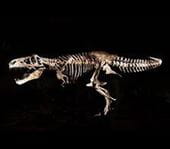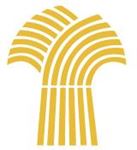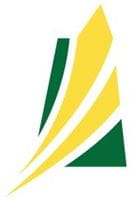
Western Red Lily
The provincial floral emblem, selected in 1941, is the western red lily, known botanically as Lilium philadelphicum L. var. andinum. It grows in moist meadows and semi-wooded areas and stands out brilliantly with its flaming red blossoms against a natural green background. The western red lily is a protected species.
Sharp-Tailed Grouse

The sharp-tailed grouse (Tympanuchus phasianellus) was selected as the province's bird emblem in 1945. It is one of Saskatchewan's most popular game birds.
White Birch

The white birch (Betula papyrifera) was adopted as the official tree of the province in 1988. A fast-growing deciduous hardwood tree, the white birch is a frequently planted ornamental species, easily recognized by its chalk-white papery bark.
Potash (Sylvite)

Sylvite is the mineral name for the chemical compound KCI, potassium chloride, commonly called potash. Potash ore is a mixture of sylvite, with lesser amounts of carnallite, halite and traces of hematite oxide (responsible for the characteristic pink to reddish-brown colour) and clay.
Potash was chosen as the provincial mineral following a province-wide competition open to Grade 8 school students, and was announced by the Minister of Energy and Mines in February 1996. It was made the official mineral emblem in 1997.
White-Tailed Deer

The white-tailed deer (Odocoileus virginianus) is one of Saskatchewan's most popular game animals, found throughout much of the province. The deer, commonly called the whitetail, is recognizable by the characteristic white underside to its tail.
The white-tailed deer first appeared in Saskatchewan emblems as an element of the armorial bearings proclaimed in 1986. It was adopted as the official animal emblem in 2001.
Needle-and-Thread Grass

The provincial grass emblem was selected by a coalition of environmental, wildlife and agricultural organizations through the Prairie Conservation Action Plan, seeking to sustain the native prairie ecosystem in a healthy state. Needle-and-thread grass (Hesperostipa comata) was chosen because it is the dominant grass of Saskatchewan's mixed grassland eco-region and is also common in the moist mixed grassland and aspen parkland eco-regions.
Needle-and-thread grass was officially adopted as the provincial grass emblem in 2001.
Saskatoon Berry

Saskatchewan's fruit emblem, the Saskatoon berry or Juneberry, is botanically known as Amelanchier alnifolia. This small, edible fruit is sweet in taste and has long been eaten by Canada's native peoples. The name derives from the Cree noun misâskwatômina. The city of Saskatoon is named after this plant. In 2005, it was recommended that the Saskatoon berry be named as one of the provincial emblems.
Walleye

Saskatchewan's fish emblem is the walleye (Sander vitreus). Saskatchewan is known for its world-class fresh water fishing and during the province's centennial in 2005, Saskatchewan Environment held a Provincial Fish Emblem Contest. Ten thousand people voted and the walleye was the overwhelming choice. On January 4, 2005, a walleye measuring 36.5" in length, 22.5" in girth and 18.3 pounds was caught in the frozen waters of Tobin Lake. In 2014, a 13.3lb Walleye was caught spearfishing on the South Saskatchewan River north of Lake Diefenbaker, which has been recognized by the International Underwater Spearfishing Association as a record.
Tyrannosaurus rex
 The Tyrannosaurus rex officially became the provincial Fossil through legislation in 2018, following a video contest for schools, an exhibit and an in-person vote lead by the Royal Saskatchewan Museum in 2016. The T. rex beat out five other candidates, and Saskatchewan became the first jurisdiction in North American to use the T. rex as an official emblem. The T. rex in Saskatchewan is personated by "Scotty," a 66-million-year-old T. rex fossil discovered in the Frenchman River Valley in 1991, and was at the time one of only a dozen T. rex skeletons in the world.
The Tyrannosaurus rex officially became the provincial Fossil through legislation in 2018, following a video contest for schools, an exhibit and an in-person vote lead by the Royal Saskatchewan Museum in 2016. The T. rex beat out five other candidates, and Saskatchewan became the first jurisdiction in North American to use the T. rex as an official emblem. The T. rex in Saskatchewan is personated by "Scotty," a 66-million-year-old T. rex fossil discovered in the Frenchman River Valley in 1991, and was at the time one of only a dozen T. rex skeletons in the world.











 The Tyrannosaurus rex officially became the provincial Fossil through legislation in 2018, following a video contest for schools, an exhibit and an in-person vote lead by the Royal Saskatchewan Museum in 2016. The T. rex beat out five other candidates, and Saskatchewan became the first jurisdiction in North American to use the T. rex as an official emblem. The T. rex in Saskatchewan is personated by "Scotty," a 66-million-year-old T. rex fossil discovered in the Frenchman River Valley in 1991, and was at the time one of only a dozen T. rex skeletons in the world.
The Tyrannosaurus rex officially became the provincial Fossil through legislation in 2018, following a video contest for schools, an exhibit and an in-person vote lead by the Royal Saskatchewan Museum in 2016. The T. rex beat out five other candidates, and Saskatchewan became the first jurisdiction in North American to use the T. rex as an official emblem. The T. rex in Saskatchewan is personated by "Scotty," a 66-million-year-old T. rex fossil discovered in the Frenchman River Valley in 1991, and was at the time one of only a dozen T. rex skeletons in the world.



 Curling has been played in what is now Saskatchewan since the 1880s. The predecessor of CURLSASK was established in 1904, the year before Saskatchewan became a province.
Curling has been played in what is now Saskatchewan since the 1880s. The predecessor of CURLSASK was established in 1904, the year before Saskatchewan became a province.

 The historic wheat sheaf was adopted in 1977 as the basic symbol of the province's visual identity program. The free-flowing design, adapted from the wheat sheaves on the shield, expresses the growth of the province and the vitality of its people. In 2013, the stylized wheat sheaf was introduced to replace this historic symbol.
The historic wheat sheaf was adopted in 1977 as the basic symbol of the province's visual identity program. The free-flowing design, adapted from the wheat sheaves on the shield, expresses the growth of the province and the vitality of its people. In 2013, the stylized wheat sheaf was introduced to replace this historic symbol. The stylized wheat sheaf was introduced in 2013 as a part of the logo of the Government of Saskatchewan. The design features two yellow lines, evoking the historic wheat sheaf, which grow in an upward motion over a green form of the province. This design expresses opportunity, growth and the potential of the province and its people.
The stylized wheat sheaf was introduced in 2013 as a part of the logo of the Government of Saskatchewan. The design features two yellow lines, evoking the historic wheat sheaf, which grow in an upward motion over a green form of the province. This design expresses opportunity, growth and the potential of the province and its people.